Introduction: Meiosis Creates Genetic Variation
One key idea to take away from everything that we’ve learned about meiosis so far is that meiosis reduces chromosome number from diploid to haploid. Here’s a second idea: meiosis, along with fertilization, creates genetic variation. That second idea is going to be the focus of this tutorial.
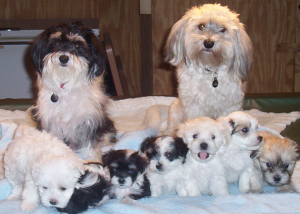
You can think of this variation as having two dimensions:
- A horizontal dimension (within a generation). In any family, meiosis and fertilization are why the offspring in that family are genetically different from one another. If you have a biological brother or a sister, meiosis is the reason why you’re genetically different— despite having the same parents.
- A vertical dimension (between generations). Meiosis and fertilization ensure that each generation is genetically different from the parent generation that created it. Meiosis is why you’re genetically different from your parents.
How does meiosis create variation? In terms of the actual, cellular processes, two things occur:
- As meiosis reduces chromosome number from diploid (two sets) to haploid (one set), a cellular “choice” has to be made. The choice is this: for each homologous pair, which chromosome (maternal or paternal) will be sent to the haploid gamete?
As we’ll see, for each pair, the choice is random: it’s essentially a coin toss. And, most importantly, what happens with each pair is independent of every other pair. In other words, for the first homologous pair, the choice of which chromosome gets sent to the gamete might be the paternal chromosome, while for the second pair it might be the maternal chromosome. This process is called independent assortment. I’ll expand on its mechanism and consequences below. - What you just read immediately above focused on a “choice” between maternal and paternal chromosomes. But what would be more accurate to say would be “mostly maternal” and “mostly paternal” chromosomes. That’s because at the very start of meiosis, a process called crossing over occurs. During crossing over, the chromosomes in each homologous pair swap sections of their DNA. This creates recombinant chromosomes. These recombinant chromosomes are the DNA that parents pass to their offspring through egg cells or sperm cells. This DNA is truly new, consisting of sequences that have never existed before.
1. Understanding Independent Assortment
It’s easier to understand meiosis if we keep these two processes (independent assortment and crossing over) separate. So, let’s continue by looking at independent assortment, pretending that crossing over hasn’t happened.
To keep this as simple as possible, we’ll use, as our example, a cell with four chromosomes. That means that the diploid number is 4. The haploid number is 2. In what follows,
- “P1” means “chromosome 1, from the father” (the “P” stands for “Paternal”).
- “M1” means “chromosome 1, from the mother” (the “M” stands for “Maternal”)
- “P2” means “paternal chromosome 2.”
- “M2” means “maternal chromosome 2.”
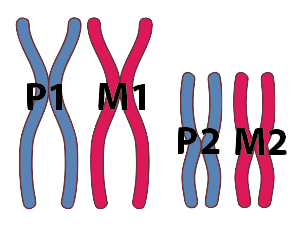 If you were to make a karyotype of a germ cell in the ovary or testes right before that cell underwent meiosis, it would look like what’s shown at left. You should notice right away that the chromosomes are doubled (consisting of two sister chromatids), a result of the chromosome duplication that occurs right at the start of meiosis, during what’s called interphase 1.
If you were to make a karyotype of a germ cell in the ovary or testes right before that cell underwent meiosis, it would look like what’s shown at left. You should notice right away that the chromosomes are doubled (consisting of two sister chromatids), a result of the chromosome duplication that occurs right at the start of meiosis, during what’s called interphase 1.
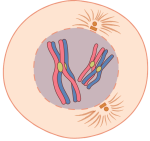
Interphase 1 is followed by prophase 1. During prophase 1, enzymes find each member of the homologous pair and pair them up. These homologous partners physically embrace one another, with maternal chromosome 1 embracing paternal chromosome 1, and so on. You can see this embrace on the right. These homologs will hold on to one another until they get pulled apart, later in the process. But the main idea, for now, is that the homologous pairs are together, and can be manipulated as a unit.
Next, spindle fibers grab the homologous pairs, and pull them to the cell equator. This moment, when homologous pairs are lined up in the middle of the germ cell, is metaphase 1. As this lining up occurs, the orientation of the paternal and maternal chromosomes is completely random. So, one way that the cell could organize its chromosomes is as shown below:
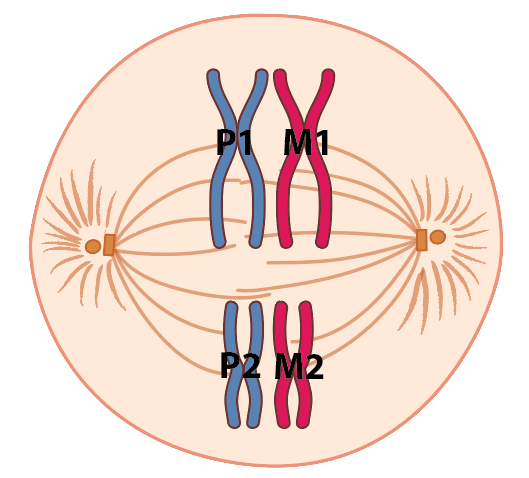
Notice that for both chromosomes 1 and 2, the paternal chromosome is on the left, and the maternal chromosome is on the right.
When this cell undergoes the first cell division of meiosis, P1 and P2 would be pulled toward the left, and M1 and M2 would be pulled toward the right. The resulting haploid daughter cells would be like what’s shown below: The daughter cell on the left has two paternal chromosomes (P1 and P2). The daughter cell on the right has two maternal chromosomes (M1 and M2).
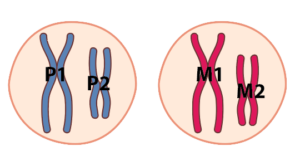
But the chromosomal arrangement in this germ cell could just have easily been this:
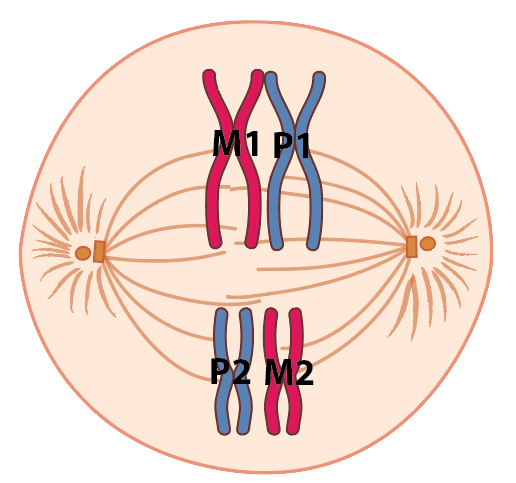
Notice that M1 is on the left and P1 is on the right, with P2 and M2 in the same position as in the illustration above.
When this germ cell undergoes the first cell division of meiosis, the resulting haploid daughter cells would be like this:
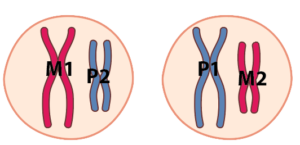
The haploid daughter cell on the left has one maternal and one paternal chromosome (M1 and P2). The haploid daughter on the right also has one maternal and one paternal chromosome (but a different combination, P1 and M2).
You can play around and try to find different combinations of chromosomes in the haploid daughter cells. Not to spoil your fun, but if the goal is to create new combinations of maternal and paternal chromosomes in the daughter cells, you won’t succeed. In a cell with four chromosomes (P1, M1, P2, M2) you can only create four chromosomally unique gametes: (P1:P2); (P1:M2); (M1:P2); (M1:M2).
If you’re mathematically minded, then you might notice that you can use the FOIL method for factoring a binomial to figure out the chromosomes in the gametes. FOIL is an acronym, and it stands for first, outside, inside, and last. With two homologous pairs, P1, M1, and P2, M2, then the first of each pair is P1:P2. The outside pair is P1:M2. The inside pair is M1:P2. The last is M1, M2.
Why can’t you have combinations like M1:P1 or M2:P2? Remember that meiosis is about sending information about how to grow, develop, and interact with the environment from one generation to the next. As I discussed above, each homologous pair is like a recipe book, with recipes for enzymes, other proteins, various RNAs, and so on. Those recipes, of course, are genes. A gamete that was M1:P1 would be missing all of the recipes/genes that reside on chromosome 2, resulting in what would probably be a non-viable gamete, and almost certainly a non-viable organism.
With more than two pairs of chromosomes (and remember that we humans have 23 pairs), working out the number of possible combinations can be overwhelming. So try it with a germ cell that has three homologous pairs, as shown below:
[qwiz style = “min-height:0px;” qrecord_id=”sciencemusicvideosMeister1961-Meiosis and Gametic Chromosomal Combinations”]
[h]Meiosis and Gametic Chromosomal Combinations
[q]In a cell with three homologous pairs [(P1: M1), (P2: M2), (P3, M3)] how many combinations of chromosomes can result in the haploid daughter cells? You might be able to do this in your head, but you’ll learn more if you grab a piece of scrap paper and chart out all the possible combinations, first in the germ cells, and then in the haploid gametes.
[c]IFNob3cgdGhlIGFuc3dlcg==[Qq]
[f]WW91IG1pZ2h0IG5vdCBoYXZlIGFycmFuZ2VkIHRoZSBwcm9ibGVtIGV4YWN0bHkgYXMgSSBkaWQsIGJ1dCBJIGhvcGUgdGhhdCB5b3UgYWxzbyBmb3VuZCB0aGVyZSB0byBiZSBlaWdodCBwb3NzaWJsZSBjb21iaW5hdGlvbnMgb2YgY2hyb21vc29tZXMgaW4gdGhlIGhhcGxvaWQgZGF1Z2h0ZXIgY2VsbHMu
Cg==| [Qq]Diploid germ cell about to divide |
P1, M1 P2, M2 P3, M3 |
M1, P1 P2, M2 P3, M3 |
M1, P1 M2, P2 P3, M3 |
P1, M1 M2, P2 P3, M3 |
||||
| Haploid daughter cell | P1
P2 P3 |
M1
M2 M3 |
M1
P2 P3 |
P1
M2 M3 |
M1
M2 P3 |
P1
P2 M3 |
P1
M2 P3 |
M1
P2 P3 |
[/qwiz]
There’s an easy formula for figuring out the number of unique chromosomal combinations in the haploid daughter cells. Notice that with two homologous pairs of chromosomes, we can create four unique combinations. That’s 22. With three homologous pairs, there are 8 possibilities, which is 23. To generalize, the formula is 2(number of homologous pairs). So with four homologous pairs, there are 24, which is 16. With five homologous pairs, there are 25, which is 32.
In humans, with 23 homologous pairs, the number of chromosome combinations in any gamete is 223, or 8,388,608. What does that mean? It means that when your father created the sperm that gave rise to you and your siblings, there was only a 1/8,388,608 chance that the array of maternal and paternal chromosomes that he would pass on in any two sperm would be the same. And when you think about the fact that your mother was doing the same thing as she created the eggs that led to you and your siblings, the chance that you and your siblings would inherit the same array of maternal and paternal chromosomes becomes infinitesimal: 1/223 times 1/223 =1/246, which is about 1/70 trillion.
[qwiz qrecord_id=”sciencemusicvideosMeister1961-Independent Assortment: Checking Understanding”]
[h]Independent Assortment: Checking Understanding
[i]
[q]The key idea behind independent assortment is that each pair of homologous chromosomes is divided up [hangman] from every other pair.
[c]aW5kZXBlbmRlbnRseQ==[Qq]
[q]During metaphase 1 (shown below) the way that maternal and paternal chromosomes line up is as [hangman] as a coin toss.
[c]cmFuZG9t[Qq]
[q]INSTRUCTIONS: spell out the numbers.
The cell below has [hangman] homologous pairs. That means that meiosis can create [hangman] possible combinations of chromosomes.
[c]dHdv[Qq]
[c]Zm91cg==[Qq]
[q]INSTRUCTIONS: spell out the numbers.
In a cell with three homologous chromosomes, meiosis can result in [hangman] possible combinations of chromosomes.
[c]ZWlnaHQ=[Qq]
[/qwiz]
2. Crossing Over
Independent assortment is just one way that meiosis creates variety. The second process involves the combining of maternal and paternal DNA into hybrid, completely novel chromosomes. This eliminates the chance that any two siblings would receive the same DNA from their parents (even in a species with one homologous pair, much less in humans, which have 23 pairs). Here’s what happens.
As mentioned above, before the homologous pairs get pulled to the middle of the cell, enzymes find the homologous pairs and bring them together. The units that form as homologous pairs are paired up are called tetrads (the prefix “tetra” means “four”). Thus, in prophase I (we’ll go over all the phases below), a cell undergoing meiosis looks like this:
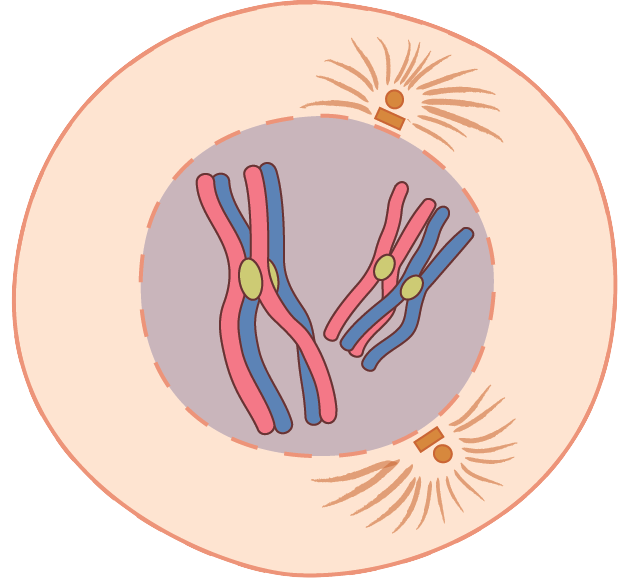
Each tetrad consists of two homologous chromosomes, each of which consists of two sister chromatids. The homologous chromatids touch one another at a point that’s called a chiasma (see the red arrow below). In other words, the chiasma is connecting a chromatid inherited from the father with a chromatid inherited from the mother. This process of coming together is called synapsis.
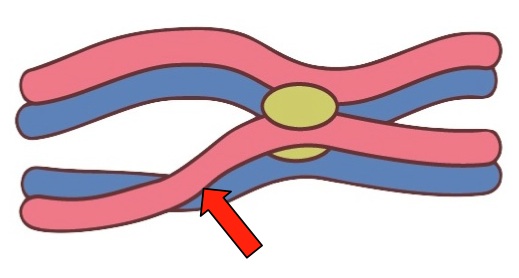
At the chiasma, other enzymes will cut these non-sister homologous chromatids and move them over to the matching spot on their homologous partners. You can see the result in the diagram below. If we (very stereotypically) color code the maternal chromosome as pink and the paternal one as blue, then you can see how the tip of the right chromatid in the maternal chromosome on the left now has a bit of blue paternal DNA, and the tip of the leftmost blue paternal chromatid on the right now has some pink maternal DNA.
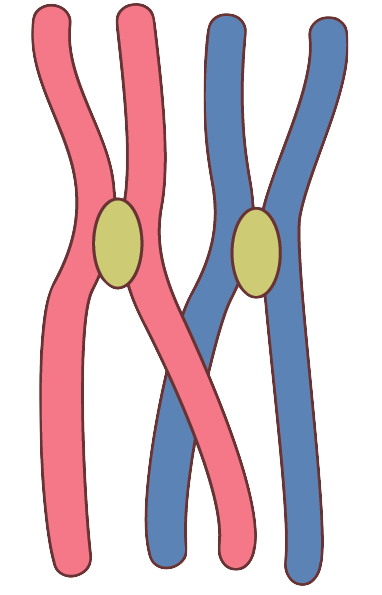 |
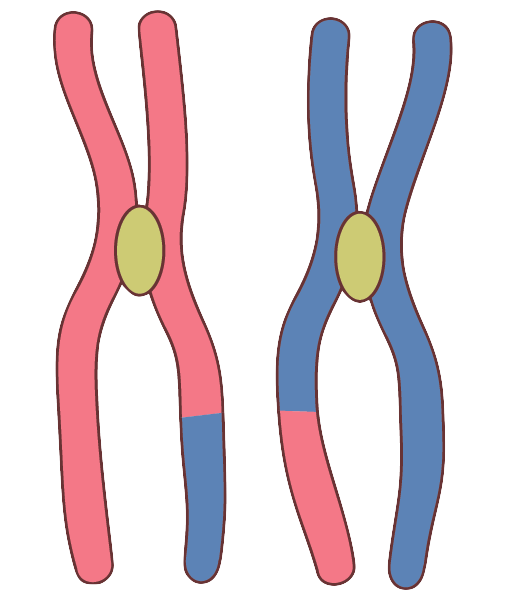 |
| A tetrad during synapsis, before crossing over | Recombinant chromosomes after crossing over |
Meiosis, in other words, creates recombinant DNA. You’ve probably learned about recombinant DNA in your studies of genetic engineering, where DNA from different species is spliced together. In meiosis, what’s being spliced together is the DNA you inherited from your mother and father. You recombine this DNA into new DNA, and then (if you choose to have offspring) you’ll pass this recombined DNA on to the next generation. The same process, of course, occurred when you were created. That means that your DNA is also new and unique. So, if your mom or dad (or other people in your life) tell you that you’re special and unique, don’t roll your eyes. It’s true: unless you’re an identical twin, the DNA in each of your cells is a never before seen sequence, a truly new thing in our universe. Of course, that doesn’t make you any more special than anyone else, because everyone else is exactly as special and unique as you are.
3. Quiz: Meiosis and Variation
The quiz below covers the various ways that meiosis creates variation:
- crossing over
- independent assortment
[qwiz qrecord_id=”sciencemusicvideosMeister1961-meiosisAndVariation”]
[h]Quiz: Meiosis and Variation
[i]
[q] As shown in the diagram below, the pairing up of homologous chromosomes is also known as
[c]IGEgY2hpYXNtYQ==[Qq]
[c]IHByb3BoYXNlIDE=[Qq]
[c]IHN5bm Fwc2lz[Qq]
[c]IHRldHJhZGl6YXRpb24=[Qq]
[f]IE5vLiBBIGNoaWFzbWEgaXMgYSBzcG90IHdoZXJlIHRoZSBjaHJvbWF0aWRzIGxpbmsgdG9nZXRoZXIuIFlvdSBjYW4gc2VlIHRoZSBjaGlhc21hLCBidXQgdGhlIHByb2Nlc3MgaGFzIGEgZGlmZmVyZW50IG5hbWUu[Qq]
[f]IE5vLiBUaGlzIHByb2Nlc3MgaXMgb2NjdXJyaW5nIGR1cmluZyBwcm9waGFzZSAxLCBidXQgdGhhdOKAmXMgbm90IHRoZSBuYW1lIGZvciB0aGUgcGFpcmluZyB1cCBvZiBob21vbG9nb3VzIGNocm9tb3NvbWVzLg==[Qq]
[f]IENvcnJlY3QuIFN5bmFwc2lzIGlzIHRoZSBuYW1lIGZvciB0aGUgcHJvY2VzcyB3aGVyZSBob21vbG9nb3VzIGNocm9tb3NvbWVzIHBhaXIgdXAgKGFuZCBleGNoYW5nZSBnZW5lcyku[Qq]
[f]IE5vLiBUaGUgdW5pdCB0aGF04oCZcyBtYWRlIG9mIHR3byBob21vbG9nb3VzIGNocm9tb3NvbWVzLCB3aGljaCBpbiB0dXJuIGNvbnNpc3RzIG9mIGZvdXIgc2lzdGVyIGNocm9tYXRpZHMsIGlzIGtub3duIGFzIGEgdGV0cmFkLiBCdXQgdGV0cmFkaXphdGlvbiBpcyBhIHRlcm0gdGhhdCBJIG1hZGUgdXAganVzdCBhcyBhIGRpc3RyYWN0b3IuIE5leHQgdGltZSwgbWFrZSBhbm90aGVyIGNob2ljZS4=[Qq]
[q] In the diagram below, these paired homologous chromosomes can also be referred to as a
[c]IGEgY2hpYXNtYQ==
[c]IGNyb3Nzb3ZlciBwb2ludA==[Qq]
[c]IHN5bmFwc2lz[Qq]
[c]IHRldH JhZA==[Qq]
[f]IE5vLiBBIGNoaWFzbWEgaXMgYSBzcG90IHdoZXJlIHRoZSBjaHJvbWF0aWRzIGxpbmsgdG9nZXRoZXIuIFlvdSBjYW4gc2VlIHRoZSBjaGlhc21hLCBidXQgdGhlIG92ZXJhbGwgZ3JvdXBpbmcgaGFzIGEgZGlmZmVyZW50IG5hbWUuIE9uZSAob2JzY3VyZSkgaGludCBpcyB0aGF0IHRoZXJlIGFyZSBmb3VyIHNpc3RlciBjaHJvbWF0aWRzLiBUaGluayBvZiBhIHByZWZpeCB0aGF0IG1lYW5zIGZvdXImIzgyMzA7[Qq]
[f]IE5vLiBUaGUgYXJlYSB3aGVyZSB0aGUgYXJtcyBvZiB0aGUgY2hyb21hdGlkcyBhcmUgb3ZlcmxhcHBpbmcgbWF5LCBpbmRlZWQsIGJlIGEgY3Jvc3NvdmVyIHBvaW50LCBidXQgdGhhdOKAmXMgbm90IHRoZSBuYW1lIGZvciB0aGlzIHVuaXQgb2YgZm91ciBzaXN0ZXIgY2hyb21hdGlkcy4=[Qq]
[f]IE5vLiBTeW5hcHNpcyBpcyB0aGUgbmFtZSBmb3IgdGhlIHByb2Nlc3Mgd2hlcmUgaG9tb2xvZ291cyBjaHJvbW9zb21lcyBwYWlyIHVwIChhbmQgZXhjaGFuZ2UgZ2VuZXMpLiBCdXQgaXTigJlzIG5vdCB0aGUgbmFtZSBmb3IgdGhpcyB1bml0IG9mIGZvdXIgc2lzdGVyIGNocm9tYXRpZHMu[Qq]
[f]IFllcy4gVGhlIHVuaXQgdGhhdOKAmXMgbWFkZSBvZiB0d28gaG9tb2xvZ291cyBjaHJvbW9zb21lcywgd2hpY2ggaW4gdHVybiBjb25zaXN0cyBvZiBmb3VyIHNpc3RlciBjaHJvbWF0aWRzLCBpcyBhbHNvIGtub3duIGFzIGEgdGV0cmFkLg==
Cg==[Qq]
[q] In the diagram below, the arrow indicates a
[c]IGNoaW FzbWE=[Qq]
[c]IGNyb3Nzb3ZlciBwb2ludA==[Qq]
[c]IHN5bmFwc2lz[Qq]
[c]IHRldHJhZA==[Qq]
[f]IFllcy4gQSBjaGlhc21hIGlzIHRoZSBzcG90IHdoZXJlIHRoZSBjaHJvbWF0aWRzIGxpbmsgdG9nZXRoZXIu[Qq]
[f]IE5vLiBUaGUgYXJlYSB3aGVyZSB0aGUgYXJtcyBvZiB0aGUgY2hyb21hdGlkcyBhcmUgb3ZlcmxhcHBpbmcgbWF5LCBpbmRlZWQsIGJlIGEgY3Jvc3NvdmVyIHBvaW50LCBidXQgdGhhdOKAmXMgbm90IHRoZSBuYW1lIGZvciB0aGlzIGFyZWEgb2Ygb3ZlcmxhcCBiZXR3ZWVuIGNocm9tYXRpZHMu[Qq]
[f]IE5vLiBTeW5hcHNpcyBpcyB0aGUgbmFtZSBmb3IgdGhlIHByb2Nlc3Mgd2hlcmUgaG9tb2xvZ291cyBjaHJvbW9zb21lcyBwYWlyIHVwIChhbmQgZXhjaGFuZ2UgZ2VuZXMpLiBCdXQgdGhhdOKAmXMgbm90IHRoZSBuYW1lIGZvciB0aGlzIHBvaW50IG9mIG92ZXJsYXAu[Qq]
[f]IE5vLiBUaGUgdW5pdCB0aGF04oCZcyBtYWRlIG9mIHR3byBob21vbG9nb3VzIGNocm9tb3NvbWVzLCB3aGljaCBpbiB0dXJuIGNvbnNpc3RzIG9mIGZvdXIgc2lzdGVyIGNocm9tYXRpZHMsIGlzIGtub3duIGFzIGEgdGV0cmFkLiBCdXQgdGhhdOKAmXMgbm90IHRoZSBuYW1lIGZvciB0aGlzIHBvaW50IG9mIG92ZXJsYXAu
Cg==[Qq]
[q] The tetrad shown below shows what process?
[c]IEROQSByZXBsaWNhdGlvbg==[Qq]
[c]IENyb3NzaW 5nIG92ZXI=[Qq]
[c]IEluZGVwZW5kZW50IGFzc29ydG1lbnQ=[Qq]
[f]IE5vLiBUaGUgRE5BIHdhcyByZXBsaWNhdGVkIGR1cmluZyBpbnRlcnBoYXNlLiBGb3IgYSBiZXR0ZXIgYXBwcm9hY2ggdG8gdGhpcyBxdWVzdGlvbiwgbm90ZSBob3cgdGhlIHRpcHMgb2YgdHdvIG9mIHRoZSBjaHJvbWF0aWRzIGhhdmUgc3dpdGNoZWQgY29sb3Iu[Qq]
[f]IFllcy4gVGhlIHRpcHMgb2YgZWFjaCBjaHJvbWF0aWQgaGF2ZSBjcm9zc2VkIG92ZXIgdG8gdGhlIG90aGVyIG1lbWJlciBvZiB0aGUgaG9tb2xvZ291cyBwYWlyLiBUaGUgcmVzdWx0IGlzIHJlY29tYmluYW50IGNocm9tb3NvbWVzLCBicmFuZC1uZXcgcGllY2VzIG9mIEROQS4=[Qq]
[f]IE5vLiBXaGlsZSB0aGF04oCZcyBhbiBpbmNyZWRpYmx5IGltcG9ydGFudCBmZWF0dXJlIG9mIG1laW9zaXMsIGl0IG9jY3VycyBsYXRlciBpbiBtZWlvc2lzLCBhZnRlciBwcm9waGFzZSAxLg==
Cg==[Qq]
[q] The tetrad shown here illustrates the creation of
[c]IHJlcGxpY2F0ZWQgRE5B[Qq]
[c]IGhvbW9sb2dvdXMgcGFpcnM=[Qq]
[c]IHJlY29tYmluYW50 IGNocm9tb3NvbWVz[Qq]
[f]IE5vLiBUaGUgRE5BIHdhcyByZXBsaWNhdGVkIGR1cmluZyBpbnRlcnBoYXNlLiBBcyBhIGhpbnQsIG5vdGUgdGhhdCBhcyBhIHJlc3VsdCBvZiBjcm9zc2luZyBvdmVyLCB0aGVyZeKAmXMgYSBuZXcgY29tYmluYXRpb24gb2YgZ2VuZXMu[Qq]
[f]IE5vLiBUaGUgdGV0cmFkIGlzIGEgaG9tb2xvZ291cyBwYWlyLCBidXQgdGhhdOKAmXMgbm90IHdoYXTigJlzIGJlaW5nIGNyZWF0ZWQuIEFzIGEgaGludCwgbm90ZSB0aGF0IGFzIGEgcmVzdWx0IG9mIGNyb3NzaW5nIG92ZXIsIHRoZXJl4oCZcyBhIG5ldyBjb21iaW5hdGlvbiBvZiBnZW5lcy4=[Qq]
[f]IFllcy4gQ3Jvc3Npbmcgb3ZlciByZXN1bHRzIGluIGJyYW5kIG5ldyBzZXF1ZW5jZXMgb2YgRE5BLCB3aXRoIG5ldyBjb21iaW5hdGlvbnMgb2YgZ2VuZXM7IEhlbmNlLCByZWNvbWJpbmFudCBjaHJvbW9zb21lcy4=
Cg==[Qq]
[q] This diagram shows two homologous chromosomes at the end of prophase 1. What’s the best explanation for the region of swapped color on each of the innermost chromatids?
[c]IEROQSBwb2x5bWVyYXNlIGFuZCBvdGhlciBlbnp5bWVzIGNvcGllZCB0aGUgY2hyb21vc29tYWwgRE5BLg==[Qq]
[c]IGdlbmV0aWMgcmVj b21iaW5hdGlvbg==[Qq]
[c]IGluZGVwZW5kZW50IGFzc29ydG1lbnQ=[Qq]
[f]IE5vLiBUaGF0IGRpZCBoYXBwZW4gZHVyaW5nIGludGVycGhhc2UsIGJ1dCBpdCBkb2VzbuKAmXQgZXhwbGFpbiB0aGUgc3dhcHBlZCBjaHJvbW9zb21hbCByZWdpb25zIG9uIHRoZSBib3R0b20gb2YgdGhlIGNocm9tYXRpZHMu[Qq]
[f]IFllcy4gVGhlIGhvbW9sb2dvdXMgY2hyb21vc29tZXMgaGF2ZSBzd2FwcGVkIHJlZ2lvbnMgb2YgZ2VuZXMuIEFzIGEgcmVzdWx0LCB0aGV54oCZdmUgZm9ybWVkIGJyYW5kIG5ldywgcmVjb21iaW5hbnQgY2hyb21vc29tZXMu[Qq]
[f]IE5vLiBJbmRlcGVuZGVudCBhc3NvcnRtZW50IGlzIGFuIGltcG9ydGFudCBzb3VyY2Ugb2YgdmFyaWF0aW9uLCBidXQgaXQgb2NjdXJzIGFmdGVyIHN5bmFwc2lzLg==
Cg==[Qq]
[q] What’s the big idea behind this screenshot of metaphase 1 from ‘Meiosis!’ (Mr. W’s meiosis song)?
[c]IE1laW9zaXMgY3JlYXRlcyB2YXJpYXRpb24gdG hyb3VnaCBpbmRlcGVuZGVudCBhc3NvcnRtZW50[Qq]
[c]IE1laW9zaXMgcmVkdWNlcyBjaHJvbW9zb21lIG51bWJlci4=[Qq]
[f]IFllcy4gQmVjYXVzZSBob21vbG9nb3VzIGNocm9tb3NvbWVzIHJhbmRvbWx5IGxpbmUgdXAgZHVyaW5nIG1ldGFwaGFzZSwgbWF0ZXJuYWwgYW5kIHBhdGVybmFsIGNocm9tb3NvbWVzIGFyZSByYW5kb21seSBtaXhlZCB1cCBkdXJpbmcgZ2FtZXRlIGNyZWF0aW9uLiBUaGF04oCZcyBhbiBpbXBvcnRhbnQgc291cmNlIG9mIHRoZSB2YXJpYXRpb24gdGhhdCBjb21lcyBvdXQgb2YgbWVpb3Npcy4=[Qq]
[f]IE5vLiBNZWlvc2lzIGRvZXMgcmVkdWNlIGNocm9tb3NvbWUgbnVtYmVyLiBCdXQgdGhlIGlkZWEgaGVyZSByZWxhdGVzIHRvIHRoZSBjcmVhdGlvbiBvZiB2YXJpYXRpb24gdGhyb3VnaCByYW5kb20gbWl4aW5nIGFuZCBtYXRjaGluZyBvZiBtYXRlcm5hbCBhbmQgcGF0ZXJuYWwgY2hyb21vc29tZXMsIGFuZCB0aGF0IGNvbWVzIGFib3V0IHRocm91Z2ggdGhlIHdheSB0aGF0IGNocm9tb3NvbWVzIHJhbmRvbWx5IGxpbmUgdXAgZHVyaW5nIG1ldGFwaGFzZSAxLg==
Cg==[Qq]
[q] In an organism with four chromosomes, or two homologous pairs (which is what is shown in this diagram) how many combinations of maternal and paternal chromosomes can occur in the gametes?
[c]IDE=[Qq]
[c]IDI=[Qq]
[c]IDM=[Qq]
[c]ID Q=[Qq]
[f]IE5vLiBFYWNoIG9mIHRoZSBob21vbG9nb3VzIHBhaXJzIGhhcyB0d28gcG9zc2libGUgb3JpZW50YXRpb25zIChpbiB0aGlzIGRpYWdyYW0sIHRoYXQgd291bGQgYW1vdW50IHRvIHR3byB3YXlzIG9mIGZhY2luZyBub3J0aCBvciBzb3V0aCkuIFRoZSBudW1iZXIgb2YgcG9zc2libGUgYXJyYW5nZW1lbnRzIGlzIHR3byB0byB0aGUgbnVtYmVyIG9mIHBhaXJzIChpbiB0aGlzIGNhc2UsIHR3byBzcXVhcmVkKS4=[Qq]
[f]IE5vLiBFYWNoIG9mIHRoZSBob21vbG9nb3VzIHBhaXJzIGhhcyB0d28gcG9zc2libGUgb3JpZW50YXRpb25zIChpbiB0aGlzIGRpYWdyYW0sIHRoYXQgd291bGQgYW1vdW50IHRvIHR3byB3YXlzIG9mIGZhY2luZyBub3J0aCBvciBzb3V0aCkuIFRoZSBudW1iZXIgb2YgcG9zc2libGUgYXJyYW5nZW1lbnRzIGlzIHR3byB0byB0aGUgbnVtYmVyIG9mIHBhaXJzIChpbiB0aGlzIGNhc2UsIHR3byBzcXVhcmVkKS4=[Qq]
[f]IE5vLiBFYWNoIG9mIHRoZSBob21vbG9nb3VzIHBhaXJzIGhhcyB0d28gcG9zc2libGUgb3JpZW50YXRpb25zIChpbiB0aGlzIGRpYWdyYW0sIHRoYXQgd291bGQgYW1vdW50IHRvIHR3byB3YXlzIG9mIGZhY2luZyBub3J0aCBvciBzb3V0aCkuIFRoZSBudW1iZXIgb2YgcG9zc2libGUgYXJyYW5nZW1lbnRzIGlzIHR3byB0byB0aGUgbnVtYmVyIG9mIHBhaXJzIChpbiB0aGlzIGNhc2UsIHR3byBzcXVhcmVkKS4=[Qq]
[f]IEV4YWN0bHkuIEVhY2ggb2YgdGhlIGhvbW9sb2dvdXMgcGFpcnMgaGFzIHR3byBwb3NzaWJsZSBvcmllbnRhdGlvbnMgKGluIHRoaXMgZGlhZ3JhbSwgdGhhdCB3b3VsZCBhbW91bnQgdG8gdHdvIHdheXMgb2YgZmFjaW5nIG5vcnRoIG9yIHNvdXRoKS4gVGhlIG51bWJlciBvZiBwb3NzaWJsZSBhcnJhbmdlbWVudHMgaXMgdHdvIHRvIHRoZSBudW1iZXIgb2YgcGFpcnMgKGluIHRoaXMgY2FzZSwgdHdvIHNxdWFyZWQgPSA0IHBvc3NpYmxlIGNvbWJpbmF0aW9ucy4=
Cg==[Qq]
[q] In an organism with six chromosomes, or three homologous pairs (as shown in this diagram) how many combinations of maternal and paternal chromosomes can occur in the gametes?
[c]IDM=[Qq]
[c]IDQ=[Qq]
[c]ID g=[Qq]
[c]IDE2[Qq]
[f]IE5vLiBFYWNoIG9mIHRoZSBob21vbG9nb3VzIHBhaXJzIHdpbGwgaGF2ZSB0d28gcG9zc2libGUgb3JpZW50YXRpb25zIG9yIHdheXMgb2YgbGluaW5nIHVwLCBkdXJpbmcgbWV0YXBoYXNlLiBUaGUgbnVtYmVyIG9mIHBvc3NpYmxlIGFycmFuZ2VtZW50cyBpcyB0d28gdG8gdGhlIG51bWJlciBvZiBwYWlycyAoaW4gdGhpcyBjYXNlLCB0aHJlZSkuIFNvIHRoZSBwb3NzaWJsZSBudW1iZXIgb2YgY29tYmluYXRpb25zIGlzIHR3byB0byB0aGUgM3JkIHBvd2VyLg==[Qq]
[f]IE5vLiBFYWNoIG9mIHRoZSBob21vbG9nb3VzIHBhaXJzIHdpbGwgaGF2ZSB0d28gcG9zc2libGUgb3JpZW50YXRpb25zIG9yIHdheXMgb2YgbGluaW5nIHVwLCBkdXJpbmcgbWV0YXBoYXNlLiBUaGUgbnVtYmVyIG9mIHBvc3NpYmxlIGFycmFuZ2VtZW50cyBpcyB0d28gdG8gdGhlIG51bWJlciBvZiBwYWlycyAoaW4gdGhpcyBjYXNlLCB0aHJlZSkuIFNvIHRoZSBwb3NzaWJsZSBudW1iZXIgb2YgY29tYmluYXRpb25zIGlzIHR3byB0byB0aGUgM3JkIHBvd2VyLg==[Qq]
[f]IFllcy4gRWFjaCBvZiB0aGUgaG9tb2xvZ291cyBwYWlycyB3aWxsIGhhdmUgdHdvIHBvc3NpYmxlIG9yaWVudGF0aW9ucyBvciB3YXlzIG9mIGxpbmluZyB1cCBkdXJpbmcgbWV0YXBoYXNlLiBUaGUgbnVtYmVyIG9mIHBvc3NpYmxlIGFycmFuZ2VtZW50cyBpcyB0d28gdG8gdGhlIG51bWJlciBvZiBwYWlycyAoaW4gdGhpcyBjYXNlLCB0aHJlZSkuIFNvIHRoZSBwb3NzaWJsZSBudW1iZXIgb2YgY29tYmluYXRpb25zIGlzIHR3byB0byB0aGUgM3JkIHBvd2VyLiBUaGF0IGVxdWFscyA4IHBvc3NpYmxlIGNvbWJpbmF0aW9ucy4=[Qq]
[f]IE5vLiBFYWNoIG9mIHRoZSBob21vbG9nb3VzIHBhaXJzIHdpbGwgaGF2ZSB0d28gcG9zc2libGUgb3JpZW50YXRpb25zIG9yIHdheXMgb2YgbGluaW5nIHVwLCBkdXJpbmcgbWV0YXBoYXNlLiBUaGUgbnVtYmVyIG9mIHBvc3NpYmxlIGFycmFuZ2VtZW50cyBpcyB0d28gdG8gdGhlIG51bWJlciBvZiBwYWlycyAoaW4gdGhpcyBjYXNlLCB0aHJlZSkuIFNvIHRoZSBwb3NzaWJsZSBudW1iZXIgb2YgY29tYmluYXRpb25zIGlzIHR3byB0byB0aGUgM3JkIHBvd2VyLg==
Cg==[Qq]
[q] In an organism with 46 chromosomes, or 23 homologous pairs (as shown in this diagram) how many combinations of maternal and paternal chromosomes can occur in the gametes?
[c]IDIz[Qq]
[c]IDQ2[Qq]
[c]IDUyOSAod2hpY2ggaXMgZXF1YWwgdG8gMjMgc3F1YXJlZCk=[Qq]
[c]IG92ZXIgOC BtaWxsaW9u[Qq]
[f]IE5vLiBFYWNoIG9mIHRoZSBob21vbG9nb3VzIHBhaXJzIHdpbGwgaGF2ZSB0d28gcG9zc2libGUgb3JpZW50YXRpb25zIG9yIHdheXMgb2YgbGluaW5nIHVwLCBkdXJpbmcgbWV0YXBoYXNlLiBUaGUgbnVtYmVyIG9mIHBvc3NpYmxlIGFycmFuZ2VtZW50cyBpcyB0d28gdG8gdGhlIG51bWJlciBvZiBwYWlycyAoaW4gdGhpcyBjYXNlLCAyMykuIFNvIGl04oCZcyBhIHZlcnkgYmlnIG51bWJlci4gUmVtZW1iZXIgdGhhdCB0aGUgbmV4dCB0aW1lIHlvdSBzZWUgdGhpcyBxdWVzdGlvbi4=[Qq]
[f]IE5vLiBFYWNoIG9mIHRoZSBob21vbG9nb3VzIHBhaXJzIHdpbGwgaGF2ZSB0d28gcG9zc2libGUgb3JpZW50YXRpb25zIG9yIHdheXMgb2YgbGluaW5nIHVwLCBkdXJpbmcgbWV0YXBoYXNlLiBUaGUgbnVtYmVyIG9mIHBvc3NpYmxlIGFycmFuZ2VtZW50cyBpcyB0d28gdG8gdGhlIG51bWJlciBvZiBwYWlycyAoaW4gdGhpcyBjYXNlLCAyMykuIFNvIGl04oCZcyBhIHZlcnkgYmlnIG51bWJlci4gUmVtZW1iZXIgdGhhdCB0aGUgbmV4dCB0aW1lIHlvdSBzZWUgdGhpcyBxdWVzdGlvbi4=[Qq]
[f]IE5vLCBidXQgeW914oCZcmUgdGhpbmtpbmcgYWJvdXQgaXQgdGhlIHJpZ2h0IHdheS4gVGhlIG1pc3Rha2UgeW91IG1hZGUgd2FzIHRoYXQgeW91IHRvb2sgMjMgYW5kIHNxdWFyZWQgaXQuIEluc3RlYWQsIHRoZSBhbnN3ZXIgaXMgdHdvIHRvIHRoZSB0d2VudHktdGhpcmQgcG93ZXIuIEhlcmXigJlzIHdoeTogZWFjaCBvZiB0aGUgaG9tb2xvZ291cyBwYWlycyB3aWxsIGhhdmUgdHdvIHBvc3NpYmxlIG9yaWVudGF0aW9ucyBvciB3YXlzIG9mIGxpbmluZyB1cCwgZHVyaW5nIG1ldGFwaGFzZS4gVGhlIG51bWJlciBvZiBwb3NzaWJsZSBhcnJhbmdlbWVudHMgaXMgdHdvIHRvIHRoZSBudW1iZXIgb2YgcGFpcnMgKGluIHRoaXMgY2FzZSwgMjMpLiBSZW1lbWJlciB0aGF0IHdoZW4geW91IHNlZSB0aGlzIHF1ZXN0aW9uIGFnYWluLg==[Qq]
[f]IFllcy4gRWFjaCBvZiB0aGUgaG9tb2xvZ291cyBwYWlycyB3aWxsIGhhdmUgdHdvIHBvc3NpYmxlIG9yaWVudGF0aW9ucyBvciB3YXlzIG9mIGxpbmluZyB1cCwgZHVyaW5nIG1ldGFwaGFzZS4gVGhlIG51bWJlciBvZiBwb3NzaWJsZSBhcnJhbmdlbWVudHMgaXMgdHdvIHRvIHRoZSBudW1iZXIgb2YgcGFpcnMgKGluIHRoaXMgY2FzZSwgMjMpLiBUaGUgYWN0dWFsIG51bWJlciBpcyA4LDM4OCw2MDgu[Qq]
[x]
[restart]
[/qwiz]
4. Meiosis: The Whole Shebang
Here are the key concepts related to meiosis:
- Meiosis creates the haploid gametes that fuse during the process of sexual reproduction.
- Meiosis cuts chromosome number in half, from diploid to haploid.
- Meiosis creates variation through
- Independent assortment of maternal and paternal chromosomes.
- Combining DNA from homologous chromosomes to create new and unique recombinant chromosomes.
Remember that fertilization, which follows meiosis, amplifies the creation of variation by combining DNA from the two parents (a topic we’ll focus on more in later modules).
With these concepts in hand, let’s walk through the whole process. Note that you can scroll the text below the diagram to read my explanation of what’s happening.
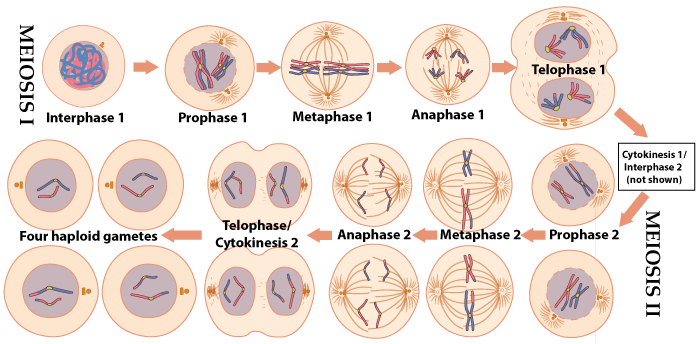
Interphase I: |
|
Meiosis begins exactly as mitosis begins: During interphase 1, the chromosomes replicate. The chromosomes at this time are spread out and can’t be seen distinctly. |
Prophase 1: |
 |
The chromosomes shorten, thicken, and become visible. Each chromosome is doubled, consisting of two sister chromatids attached by a centromere.
During prophase I, tetrads form and crossing over occurs, creating new, recombinant chromosomes. |
Metaphase 1 |
 |
Just like in mitosis, a spindle forms during meiosis. This spindle grabs the homologous pairs and pulls them to the cell equator. As we discussed above, this is where the independent assortment of chromosomes gets set up. Note that in the diagram to the left, crossing over has already occurred, so some of the chromatids are shown as recombinant chromatids.
In addition, note that while the cell above has both (mostly) maternal chromosomes on top and both (mostly) paternal ones below, the arrangement could just as easily be maternal 1 above, paternal 2 above; maternal 1 below, paternal 2 below (which, of course, is what independent assortment is all about). |
| Anaphase 1 |  |
Homologous pairs are pulled apart. One complete haploid set of chromosomes moves toward each pole of the cell. Note that each chromosome is still doubled, consisting of two sister chromatids. |
| Telophase I: | 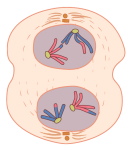 |
During telophase 1, a new nuclear membrane forms around each set of chromosomes. Each nucleus contains one member from each pair of homologous chromosomes (making them haploid). Because of crossing over and independent assortment, the nuclei are not identical, but they are equivalent in terms of the genetic information that each one contains. The word for that, of course, is homologous. |
Cytokinesis 1, Interphase 2, Prophase 2 |
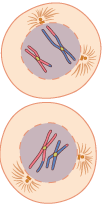 |
Cytokinesis 1 follows telophase 1, and the cell splits into two. Again, the two daughter cells are haploid, but with doubled chromosomes, each consisting of two sister chromatids.
A second interphase might follow, with chromosomes spreading out and becoming indistinct. If there is an interphase 2, there will not be an S-phase (no DNA/chromosome duplication occurs). In some species, the cells might move directly into prophase 2, as shown above. The key is that the chromosomes are condensed, and ready to be manipulated by the spindle in subsequent stages. |
Metaphase 2 |
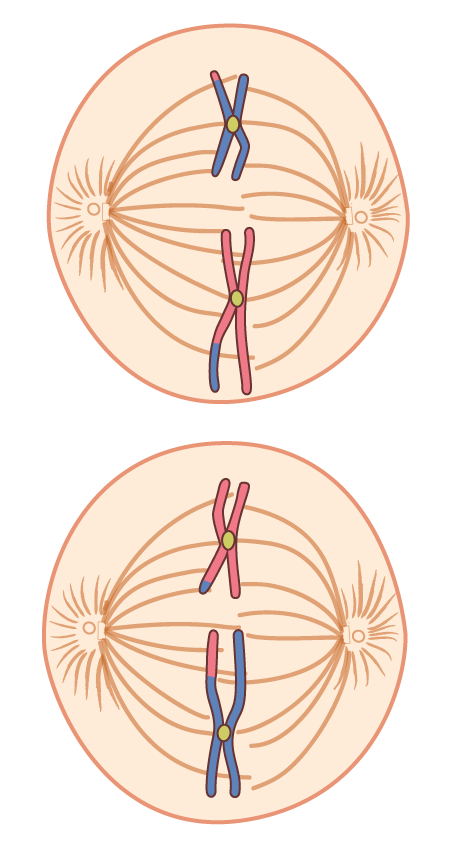 |
Another spindle forms. The doubled chromosomes are brought to the cell equator.
Note that the alignment of each pair of chromatids is separate from every other pair. That means that metaphase 2 (and the anaphase 2 that follows) constitutes another round of independent assortment, creating more variation in the gametes. |
Anaphase 2 |
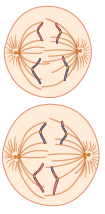 |
Sister chromatids are pulled apart. |
Telophase 2
|
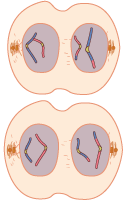 |
A nucleus forms around each set of chromosomes. Each nucleus consists of a haploid set of single (as opposed to doubled) chromosomes. |
Cytokinesis 2 |
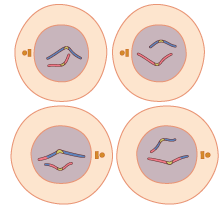 |
The cells split apart into separate cells. We now have four haploid gametes. In a male, each of these four cells will become a sperm cell. During meiosis in females, most of the cytoplasm gets shunted off to one of the four cells. That one cell will become the egg, while the other three cells are either sacrificed or go on to play a supporting role during fertilization and early development. |
5. Quiz: Phases of Meiosis
Now let’s see how well you understand how meiosis works. To keep you on your toes, I’m switching up the diagrams.
[qwiz random= “true” qrecord_id=”sciencemusicvideosMeister1961-PhasesOfMeiosis” use_dataset=”Phases of Meiosis”]
[h]Quiz: Phases of Meiosis
[i]If you need to stop before finishing, you can pick up where you left off by clicking “new” on the next card.
[/qwiz]
Next Steps
Now that you understand how meiosis works, it’s time to look at what happens when the process unfolds differently. This leads to our next tutorial.
- Click the following link for the next tutorial: Sex determination, Non-Disjunction, and Chromosomal Variation.
- Or click to return to the Meiosis Main Menu

